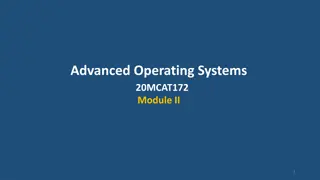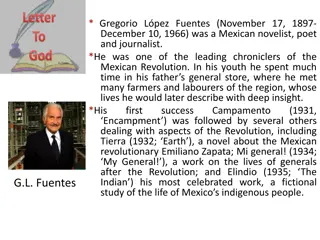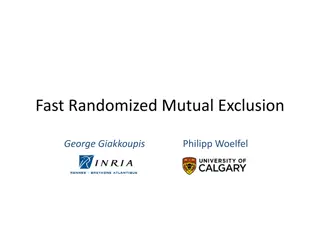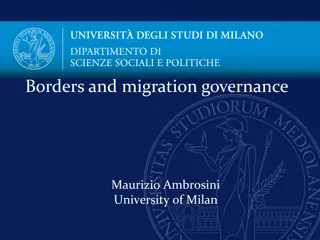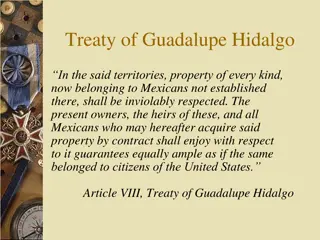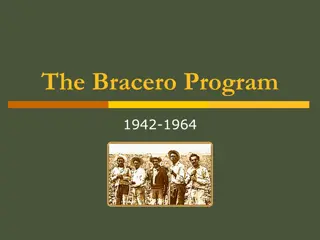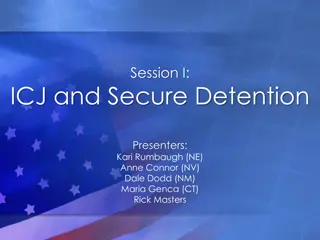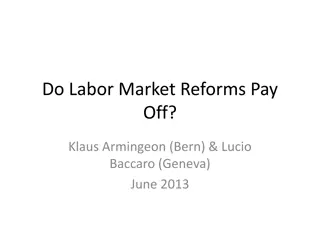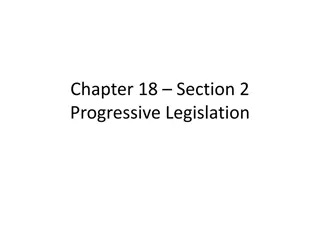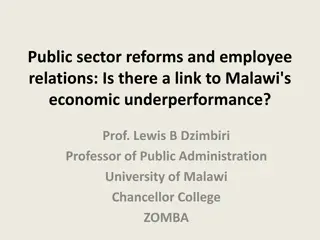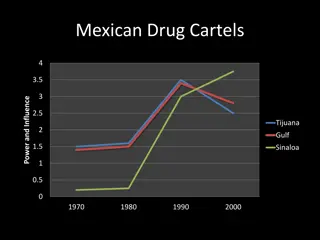Mexican Ejido Reforms: Exclusion and Control Dynamics
Explore the intricate dynamics of exclusion and control within Mexican ejido reforms, revealing historical backgrounds, the essence of ejido rural communities, the dual facets of ejidos, pre-1991 rules, state interventions, and the comprehensive reform package leading to the end of land redistribution. Gain insights into the evolution of land property forms, self-governance, conflict resolution mechanisms, and the shift towards individual property rights in the agrarian context of Mexico.
Download Presentation

Please find below an Image/Link to download the presentation.
The content on the website is provided AS IS for your information and personal use only. It may not be sold, licensed, or shared on other websites without obtaining consent from the author.If you encounter any issues during the download, it is possible that the publisher has removed the file from their server.
You are allowed to download the files provided on this website for personal or commercial use, subject to the condition that they are used lawfully. All files are the property of their respective owners.
The content on the website is provided AS IS for your information and personal use only. It may not be sold, licensed, or shared on other websites without obtaining consent from the author.
E N D
Presentation Transcript
Exclusion and control in Mexican ejido reforms Gustavo Gordillo IASC Utrecht, July 2017
THE RURAL STRONGHOLD In the XX c 11 states concentrate between 68% y 71% of rural population
HISTORICAL BACKGROUND OF THE AGRARIAN REFORM PROCESS
WHAT IS THE EJIDO RURAL COMMUNITIES: URBAN PLOT PLUS INDIVIDUAL PARCEL PLUS COMMON RESOURCES
THE EJIDO BEFORE 1991 URBAN PLOT NORMAL PRIVATE PROPERTY PARCELS PRIVATE USUS FRUCTUS COMMON LAND COLLECTIVE USUS FRUCTUS
EJIDO RULES (BEFORE 1991) Work the land directly; Could not hire wage labour. Could not rent the land or sell it. Absences from the ejido led to loss of right to the land. Ejidatarios could vote for and be elected to the Executive Committee of the ejido's Assembly. Executive Committee automatically membership to the PRI. MEXICO A ONE PARTY REGIME FROM 1929 UNTIL 1997-2000
STATE INTERVENTIONS Access to land could be gained in one of four ways: donation thru expropiation, restitution,extension, new lands. In the internal life of ejidos In arbitration In controlling the flow of public resources to the ejido (credit, trading boards and guarantee prices, fertilizers,technical assistance, irrigation,social welfare and infrastructure)
THE REFORM PACKAGE End to land redistribution The three forms of property enshrined in the Constitution: private,ejido and indigenous land For the ejido and its three components, an array of options: full property,condominium, rent, sharecropping, joint-ventures Self governed assemblies Land cadaster and registration to give titles to all ejidatarios Ombudsman to attend conflicts Special agrarian courts
THE EJIDO AFTER 1991 URBAN PLOT NORMAL PRIVATE PROPERTY PARCEL AS FARMER DECIDES FROM USUS FRUCTUS TO FULL PRIVATE PROPERTY COMMON LAND CONDOMINIUM PROPERTY
EJIDO RULES (WITH REFORM) Work the land directly; ELIMINATED Could not hire wage labour. ELIMINATED Could not rent the land or sell it. ELIMINATED Absences from the ejido led to loss of right to the land. ELIMINATED Order of heirs to their land in writing, usually naming a spouse or partner as the preferred successor. ELIMINATED Ejidatarios could vote for and be elected to the Executive Committee of the ejido's Assembly. ELIMINATED Executive Committee automatically membership to the PRI. ELIMINATED
RESULTS:TITLING AND LAND MARKETS Out of 32,047 ejidos, 30,319 ejidos and more than 95 million hectares, have been measured and titled during the period (1994-2015). About 10 per cent of the ejidos with less than 5 per cent of the ejido certified land have chosen the alternative of potential privatization of their parcels. (RAN,2015) 23,612 ejidos have reported operations of selling and buying of parcels within the ejido to other ejidatarios and neighbors involving one million parcels, 677,000 ejidatarios and 17 millions hectares.(RAN, 2017) Leasing markets?
RESULTS(2) The national average size of the plots has been reduced from 9.1 hectares to 7.5 hectares, which might suggest that consolidation of bigger parcels thru buying and selling of land has been offset by intra-family subdivisions of plots.
GOVERNANCE OF THE COUNTRYSIDE THE AUTHORITARIAN TRIANGLE THE PRESIDENCY ON THE APEX. THE MINISTRY OF AGRARIAN REFORM AS THE MINISTRY OF POLITICAL CONTROL IN THE COUNTRYSIDE THE MAIN CORPORATIST UNION CNC- AS THE INTELLIGENCE NETWORK
THE BREAKDOWN OF THE RURAL GOVERNANCE WHAT HAPPENED TO THE PRESIDENCY IN RELATION TO THE COUNTRY SIDE WHAT HAPPENES TO THE MINISTRY OF AGRARIAN REFORM WHAT HAPPENED WITH THE CORPORATIST ORGANIZATIONS
RESPONSE STRATEGIES (1) Farmers modernizing agriculture access to water bigger extension of land combining corn with fruits and vegetables, Farmers that diversify activities thru complex agriculture and cattle combinations, Farmers that diversify income thru off farm activities via wages and remittances.
RESPONSE STRATEGIES (2) Peasants which basic source of income is public funds, Peasants disconnecting from markets and developing almost autarchic livelihoods, Neighbors living in the ejido community with limited rights over the ejido lands ( an average of 85 neighbors per ejido versus 95 as full members) following mixed strategies.
RESPONSE STRATEGIES Migration domestic and international. Role of remittances Illegal activities
THE EJIDO PROJECT Hypotheses The certification process by reducing agrarian conflicts creates a new potential for governability in the countryside. Although changes in the internal governance of the ejidos have gained more autonomy to make decisions, the emergence of new black markets in economic and political aspects generates forms of corruption and clientelism. The absence of gubernmental agencies oriented towards deliverying public goods from public security to technical assistance and economic promotion has caused a crisis of gobernability
THE EJIDO PROJECT (2) The low levels of governance translates in to increased criminals actions in the countryside, reduces the impact of anti-poverty programs and weakens more the social cohesion of communities.
THE EJIDO PROJECT THE WAY FORWARD Analyzing thru interviews to ejidatarios and comuneros the way they have adapted to changes that came about with the rural reforms of 1991-1992. Our goal is 300 interviews in a sample of ejidos in the 31 states of Mexico (2016-2018). 10 case studies based on a territorial approach on links political, social and economic amongst ejidos, between ejidos and other actors and interplay urban-rural. (2018) Develop and continuously update an informatic plataform open to the public that links different databases produced by government agencies, international agencies and private companies on the ejido. (2016-2018)
THANK YOU! gusto.gustavo@gmail.com twitter @gusto47 http://gustavogordillo.blogspot.com/







